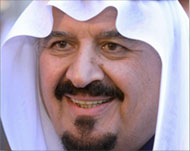Saudi succession follows tradition
Abdullah bin Abdul Aziz, the popular crown prince of Saudi Arabia, has been named the new ruler of the world’s top oil exporter after the death of his half-brother King Fahd.

It was Fahd himself who upheld the Saudi tradition of the crown prince succeeding the monarch by asking Abdullah to run the country after suffering a stroke in 1995.
Abdullah, who himself is in his early 80s, had since acted as de facto ruler of the oil-rich kingdom.
Defence Minister Prince Sultan, who is next in line to the throne after Abdullah, has been named his crown prince, as expected.
Saudi Arabia’s crown prince has traditionally replaced the king on his death or abdication, but a law introduced by Fahd opened the door for the succession to skip a generation.
The basic law adopted in 1992 also opened the way to a possible power struggle in Saudi Arabia by removing the automatic nature of the succession.
It ruled that a new king would be chosen by the Saud family as the “most capable” of the sons or grandsons of King Abdul Aziz, who founded the kingdom in 1932.
In theory, the law allowed the royal family to select a grandson of Abdul Aziz over the 20-odd surviving brothers and half-brothers of King Fahd, passing over Prince Abdullah, who leads the powerful National Guard.
According to custom, the king put forward the name of the crown prince to members of the royal family, who gave him their backing for the popular figure and sought that of the kingdom’s clerics.
Dynasty history
 |
|
Defence Minister Prince Sultan |
King Abdul Aziz had 45 known sons. On his death in 1953, his son and crown prince Saud succeeded him.
In 1964, Saud’s brother Faisal took over as the king was forced to abdicate over corruption and poor leadership.
Faisal was assassinated in 1975, and was followed by his crown prince and half-brother Khaled.
Khaled died in 1982 to be replaced by crown prince Fahd, who named Abdullah as his heir.
The Saud dynasty dates back to the 18th century, when “Lord of the Desert” Mohammad bin Saud joined forces with an austere Islamic reformer, Mohammad bin Abdul Wahhab, and set about propagating by the sword a return to pure Islam.
Their descendants survived two centuries of struggle against warring tribes and Ottoman forces.
The modern Saudi state was formed after Abdul Aziz al-Saud unified the territory by force of arms in 1932, six years before oil was first discovered in the kingdom.
The royal family today is made up of an estimated 25,000 members, of whom around 200 are princes wielding influence.
To cope with the fast-expanding dynasty, an 18-member council of senior family members led by Crown Prince Abdullah was set up in June 2000 to arbitrate in family matters between the thousands of princes.